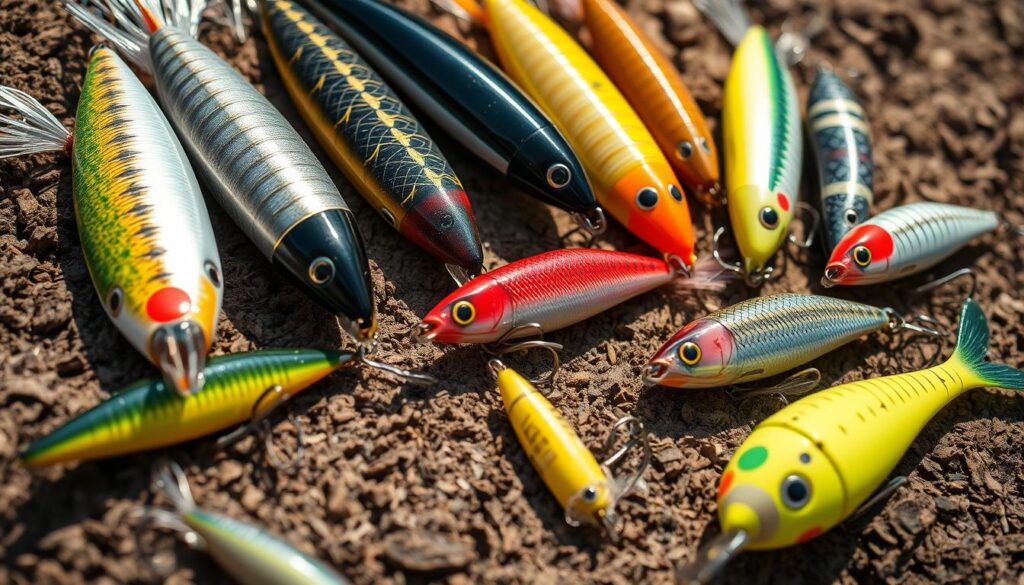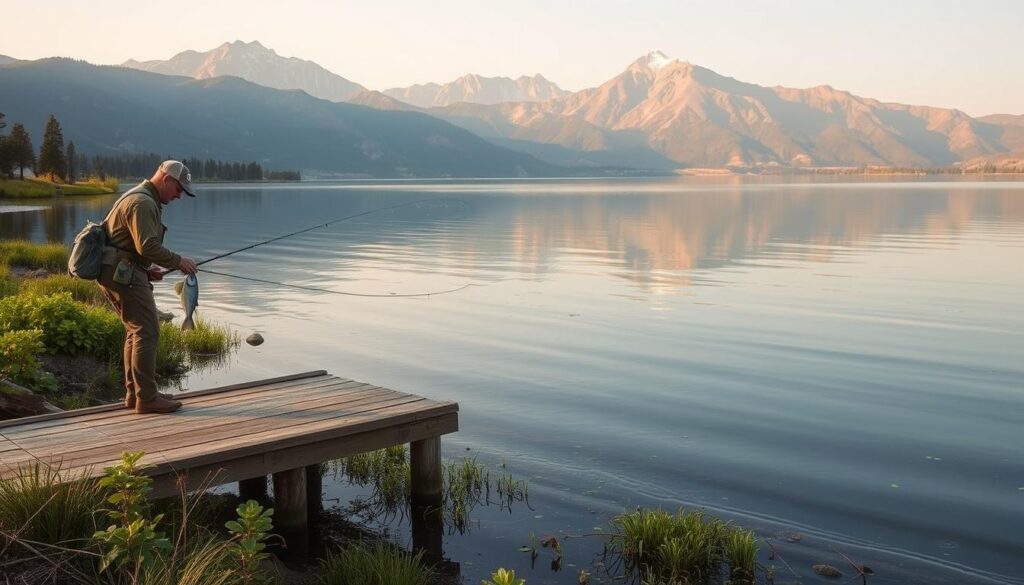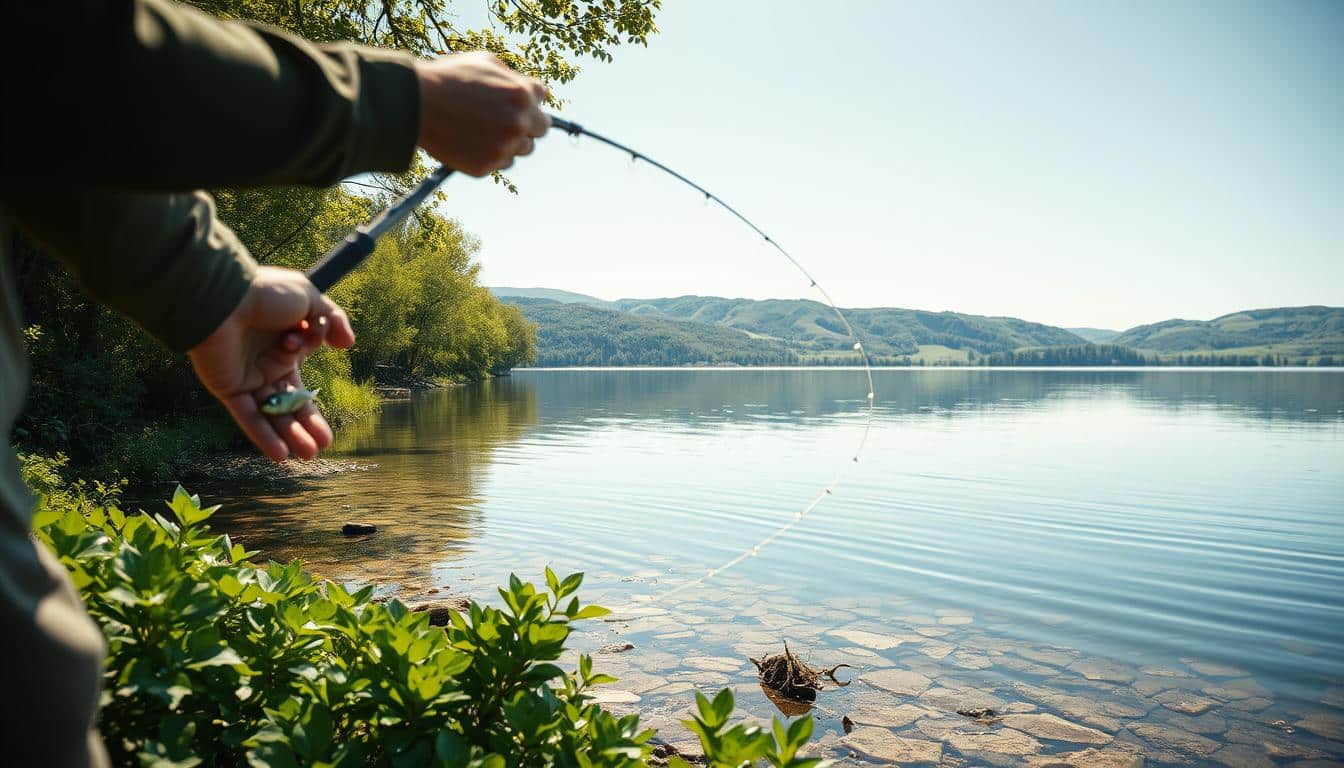Eco lures are made to break down or be safe after being lost in the water. They aim to reduce the damage that old-style gear does in our waters.
About 14 million people fish regularly in the US, and 54.5 million went fishing in 2022. With so many fishing each day, it’s vital to use greener fishing methods to lessen pollution.
Regular lures are made of materials that don’t decompose easily, like PVC and lead. They break into tiny plastics and release toxins that are bad for fish and birds. Using eco-friendly gear can help keep our waters cleaner and safer for wildlife.
This article will explain how eco lures work, look at their materials and how well they perform, and talk about other sustainable gear. We’ll share real success stories and tips for fishermen. Our aim is to encourage eco-friendly fishing to cut down on pollution.
Why anglers should care about biodegradable and eco-friendly lures
Fishing is big in the US, shaping our coasts and outdoor life. About 14 million people fish regularly, and 54.5 million did so in 2022. When many anglers make small changes, it can have a big impact. All this fishing leads to lots of gear that might get lost, cluttering our shores and rivers.
Scale of recreational fishing and potential pollution
Lots of fishing means lots of lost gear. If each angler loses just two lures each year, over 100 million lures would get lost. Studies have found that millions of feet of fishing line and sinkers are lost too. This creates a huge amount of lasting pollution in our waters.
Wildlife and habitat consequences
Animals often think soft plastic lures are food. Eating them can lead to blockages and death for birds and fish. These lures break down into microplastics, entering the food chain and possibly reaching us.
Lead in fishing gear is another danger. It releases harmful metals, damaging the health and reproduction of water creatures. Old nets and lines can trap animals, harming them over time.
Regulatory and stewardship trends
Rules are getting stricter for fishing gear, focusing on lead and single-use plastics. Anglers using safer gear are now ahead of these new rules. Big brands are creating eco-friendly products to meet this need.
Community efforts like cleanups and pledges are building better habits among anglers. More fishers are taking on the role to keep our waters clean, reducing pollution from lost gear.
Materials used in eco lures and how they biodegrade
Manufacturers mix natural stuff and special plastics to create eco lures. These are lures that fish like and nature can handle. They pick from safe food mixes for soft baits to new eco-friendly plastics for fishing. These materials work just as well but are better for the planet. This part talks about what’s in these baits, how they act in water and soil, and what labels and extra ingredients you should look for.
Common biodegradable formulations
- Gelatin lures use a mix of gelatin from animals, fish oil, and natural smells. They’re easy to make and go away quicker than many fake rubbers.
- Plant-based plastics use things like plant fibers, starch, and algae plastics. They’re stretchy without using bad chemicals.
- Food-grade thickeners and natural bits add to the feel and movement of the bait. They make sure everything used is renewable.
- Some fishing parts use recycled stuff to cut down on new plastic use. But, these aren’t the same as compostable bioplastics for fishing.
Breakdown timelines in different environments
- How fast a lure breaks down depends on what it’s made of, temperature, microbes, saltiness, and oxygen.
- In freshwater, some eco baits fall apart faster than in saltwater. Saltwater slows down the breaking down process.
- Depending on conditions, a product might break into pieces in weeks in a warm lake. But, it could take months in colder seas or even longer in bad landfills.
- Old-style PVC plastics can last for so long and create tiny plastic bits. This is the opposite of eco lures, which break down quicker and cleaner.
Certification and non-toxic additives
- Third-party checks like BPI certification make sure biodegradable claims are true. This helps avoid false “eco-friendly” claims.
- Eco-friendly lures usually don’t have harmful chemicals like phthalates or lead. They use safe materials and scents instead.
- Gelatin lures and other types often use fish oil or real smells over fake chemicals. This makes them safe without lasting pollutants.
- Fishers should look for special labels and testing info. It helps pick products that meet both fishing and earth-friendly needs.
How Eco Lures Reduce Environmental Impact
Switching to eco-friendly fishing tackle can greatly help our environment. By choosing better bait and gear, anglers can reduce the flow of hard-to-break-down plastics into our waters. This supports cleaner oceans and rivers, ensuring they stay healthy for years to come.
Reduction of long-lived plastic pollution
- Biodegradable lures take the place of harmful PVC and plastics that break down into tiny pieces over many years.
- Using compostable baits and bio-resins prevents millions of lasting plastics from polluting our water each year.
- Materials that break down easier leave behind fewer pieces that can hurt our environment and wildlife.
Lower risk of ingestion and poisoning for wildlife
- Eco-friendly formulas turn into natural elements like carbon and oxygen, making them safer for fish and birds.
- By not using lead in sinkers, we reduce the poisoning risk for waterfowl and larger fish.
- Choosing safe lures reduces the chances of animals getting sick from eating or getting stuck on them.
Mitigation of ghost fishing and gear loss impacts
- Eco-friendly nets and equipment break down over time, lessening accidental catches.
- If fishing gear is lost, using materials that break down or compost lessens harm to wildlife.
- Choosing gear that’s made to reduce ghost fishing helps protect marine life and supports coastal communities.
Performance and angler experience with eco lures
Anglers using eco-friendly lures report good catches and lifelike movements. They find Berkley Gulp and other biodegradable lures as good as traditional ones. These findings show that eco lures work well in different fishing conditions.
Studies show eco lures break down in water but keep their appeal for fish. This makes them a strong alternative to plastics. Anglers note that eco lures attract fish like bass and panfish just as well.
The lifespan of eco lures depends on their materials and the water’s warmth. Durable eco baits can be used several times if taken care of. But in warm lakes, they break down faster than in cold rivers.
- Keep soft baits cool or in a fridge to make them last longer.
- Check lures for damage after use and throw away any that are torn.
- Pick the right shape and smell of lure for the fish and water you’re in.
Test different eco lures to find what’s best for your area. Read labels and look for eco certifications to be sure of their quality. These tips help you fish responsibly while keeping your catches high.
Types of eco-friendly fishing gear that complement biodegradable lures
Anglers can lower their environmental impact by choosing the right gear. Options include nets, weights, lines, and tackles that protect fish and habitats. Here are some great choices that work well with eco-friendly lures for responsible fishing.
Biodegradable nets, traps, and lines
- New materials for nets and traps are made to break down over time. This prevents lost gear from harming fish. Knot2Shear and Europronet offer products that lessen ghost fishing and are better for the environment.
- Using nets made from recycled plastic reduces the need for new materials. Nets made from used nylon or PET help keep the oceans cleaner.
- Options for lines that break down or are easier to retrieve lower the risk to wildlife. With so much fishing line lost every year, choosing these alternatives is important for protecting nature.
Lead-free sinkers and non-toxic components
- Using sinkers made from safer materials like tin or tungsten helps prevent lead pollution. Tackle brands often list what their products are made of, making it easier to choose wisely.
- Choosing hooks and accessories that don’t leak harmful chemicals is better for our waters. Materials like stainless steel or nickel-free alloys are safer for the environment.
- Combining these with biodegradable lures makes your fishing gear fully eco-friendly. This is good for both catch-and-release practices and protecting natural habitats.
Sustainable rods, reels, and craftsmanship
- Bamboo rods are a green choice for light fishing, offering strength and a classic feel. This reduces reliance on fossil fuels used in other rod materials.
- Choosing reels made from recycled or sustainably sourced materials lessens environmental harm. Some brands focus on designs that can be fixed, extending the life of their products.
- Local artisans create high-quality tackle that lasts longer and is often repairable. Supporting these businesses helps the local economy and encourages gear maintenance over replacement.
Pairing biodegradable nets and lines with non-toxic sinkers and eco-friendly rods makes a perfect set. This way, anglers can enjoy their sport while reducing pollution and harm to aquatic life.
Case studies and real-world evidence of impact reduction
Field reports and manufacturer notes show the real deal with biodegradable tackle outdoors. Anglers and fisheries managers are sharing their stories. They match product claims with actual results on the water. These stories highlight how design and materials affect wildlife and habitats.

- Berkley Gulp biodegradation has drawn attention with company-cited timelines: faster breakdown in freshwater, slower in saltwater, and intermediate rates in landfills. Independent observers use those timelines when choosing replacements for conventional soft plastics.
- New biodegradable lure brands and small manufacturers now offer plant-based polymer and gelatin formulations. User reviews often praise catch rates and acceptable durability for weekend use.
- Home-craft gelatin baits and emerging stick baits show that simple recipes can work for many anglers while cutting long-lived plastic waste.
Community and fishery success stories
- Local cleanup efforts and stewardship campaigns such as “Pledge to Pitch It” document removed tackle and growing interest in biodegradable options. Participants report fewer lost plastics on shorelines after targeted drives.
- Indigenous and small-scale fisheries that use natural-fiber gear maintain cultural practices while supporting stock health. Case narratives link handcrafted, biodegradable traps to lower entanglement rates for birds and mammals.
- Where biodegradable nets and traps replaced conventional gear, managers recorded fewer instances of ghost fishing and reduced wildlife interactions during monitoring seasons.
Research findings and lab tests
- Lab tests biodegradable lures often focus on dissolution and microplastic generation. Multiple studies demonstrate that food-grade, biodegradable shapes dissolve faster and produce fewer persistent fragments than PVC-based plastics.
- Comparative work shows conventional soft plastics can generate microplastics under environmental stress. Biodegradable formulations tend to fragment less over the same exposure periods in controlled trials.
- Independent testing and third-party certifications, including BPI-style verifications, give buyers measurable decomposition rates and non-toxicity data for select products.
These examples and test results guide anglers in their gear choices. Tracking how gear performs in local waters helps improve biodegradable products and standards.
Barriers to adoption and practical solutions
Making the switch to eco-friendly lures presents clear challenges. Anglers, sellers, and makers must tackle issues like cost, access, and know-how. Yet, there are ways to make this shift easier while ensuring fishing remains fun and fruitful.
Cost and availability challenges
Eco-friendly lures often cost more than regular plastic ones. This can turn off those who fish for fun or businesses buying in bulk. Also, it’s hard for small shops in isolated areas to keep these green options in stock, limiting access for some.
But, there are solutions like subsidies, trade-in programs, and partnerships to help spread these products. Bulk buys by eco-friendly groups and special deals can also make these lures more affordable for those eager to try them.
Awareness and education gaps
A lot of fishermen don’t fully understand the harm caused by certain materials in their gear. This slows the switch to greener products. Clear labels, demos, and workshops by organizations can open their eyes to the benefits.
Easy-to-use outreach, like quick videos, swap meets, and signage about disposing gear correctly, can guide them towards better choices. This way, they can fish responsibly without having to change much.
Technical limitations and product development needs
Today’s eco-friendly lures vary in how long they last, how well they smell, and their strength. This makes some fishermen wary. Having set lab tests and certifications can help ensure these products are truly green and effective.
To get better eco-lures, companies should invest more in research and team up with universities. Working together on testing and standards can speed up improvements and give fishermen trustworthy options.
- Support incentives and retailer programs to ease the cost of biodegradable gear.
- Use outreach and labeling to close awareness gaps and build demand.
- Fund R&D and universal testing to improve biodegradable lure tech and increase durable, effective choices.
How anglers can maximize environmental benefits when fishing
Small choices on the water matter a lot. Choose gear and ways to fish that protect sea life and their homes. This approach makes fishing rewarding and practical.

- Opt for biodegradable lures and no-lead weights. Always read labels to steer clear of PVC, plastisol, phthalates, and lead.
- Bring back broken lures and line if you use regular gear. Use bins at ramps or shores to get rid of fishing gear the right way.
- Make a promise to always pick up lost tackle, hooks, and line after fishing. Ask friends to join in to lessen fishing litter.
Maintenance and storage to reduce waste
- Store soft baits in cool and dry places or in a fridge, as the maker suggests. This cuts down on how often you need new ones.
- Fix and update hardware instead of throwing it away. Sharpen hooks, replace split rings, and care for reels to make gear last longer.
- Carry a repair kit in your boat or bag. This can help you avoid throwing things out and buying new stuff often.
Community engagement and policy support
- Be part of local cleanups and report lost gear in science programs. These efforts make the fishing community stronger.
- Help start the use of biodegradable gear in delicate spots by working with clubs, shops, and fishery bosses. This helps create a demand.
- Push for laws that limit lead use and promote biodegradable options. Public backing can lower starting costs and make more people use them.
Conclusion
Switching to biodegradable and eco-friendly lures is a big step towards reducing fishing’s environmental impact. By eliminating long-lasting plastic debris and harmful lead, we help protect water life. Anglers can still catch lots of fish without harming aquatic ecosystems.
To fish sustainably, use lures that can break down naturally. Also, pick sinkers and hooks that don’t contain lead. Remember to throw away damaged gear the right way. When every angler makes these small changes, big improvements happen in lakes, rivers, and oceans.
Looking forward, more research and better eco-friendly products will make these choices easier. With support from communities and policies, using eco lures will become normal. This will help keep our fisheries healthy for us and future generations.
FAQ
What are eco lures and why do they matter?
How big is the pollution problem from lost fishing gear?
What wildlife and habitat harms come from lost lures and line?
What materials are used to make biodegradable lures?
How long do biodegradable lures take to break down?
Are biodegradable lures certified and truly non‑toxic?
Do eco lures actually reduce plastic pollution and wildlife poisoning?
Will fish still bite biodegradable lures compared with traditional ones?
How durable are eco lures and how should anglers handle them?
What complementary gear should anglers use with biodegradable lures?
Are there brand examples and real success stories for eco gear?
What does the research say about biodegradables versus conventional plastics?
What barriers slow adoption of eco lures and how can they be overcome?
How can anglers choose and dispose of gear to maximize benefits?
What maintenance and storage practices extend lure life and reduce waste?
How can communities and policymakers support broader adoption?
If I want to try eco lures, what practical steps should I take first?
Will widespread use of biodegradable lures solve the pollution problem?
Content created with the help of Artificial Intelligence.



